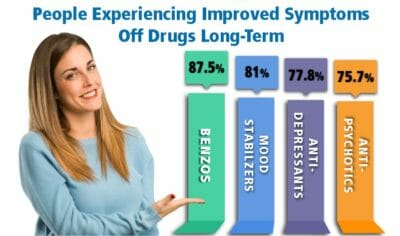Last Updated on June 12, 2024 by
Alternative to Meds Editorial Team
Medically Reviewed by Dr Samuel Lee MD
Table of Contents:

Last Updated on June 12, 2024 by
Alternative to Meds Editorial Team
Medically Reviewed by Dr Samuel Lee MD

The human brain is an incredibly complex organ that through signal conduction, processes information and performs crucial bodily functions each day. According to experts, we haven’t even begun to fully understand the intricacies of the roles of the brain when it comes to day-to-day activities. While resilient to many stressors, the brain is nonetheless sensitive – especially in children, who are still growing and developing. In people of all ages, the brain uses a system of sending and receiving molecular sense messages carried along the central nervous system, by neurotransmitters to keep the body functioning smoothly and efficiently.
Disruption of this system occurs in the presence of toxic substances in the body that can lead to dysregulation, adverse reactions and disabling injury. Despite organizations like the WHO (World Health Organization) and the FDA (Food and Drug Administration) initially labeling a chemical additive as “safe,” this does not ensure that long-term side effects won’t emerge. This is especially true in certain segments of the population with unique vulnerabilities like early or advanced age, genetics, and duration and amounts of consumption.
When cumulative, potentially harmful disruptions continue to affect the brain, devastating issues can arise. For example, a common disruptor of brain health and cognitive function is a class of chemicals known as excitotoxins. These chemicals are produced by the body in response to toxins entering the body from foods, chemicals in the workplace, or other exposures. The toxic response can be devastating, yet this threat to mental health is commonly overlooked. Continue reading for more information on excitotoxins and their role in health.9,10
Excitotoxins are chemical compounds (natural or manmade) that are capable of overstimulating or damaging human neurons. Some excitatory neurotransmitters are already present in the brain and body, such as glutamate, often called “the master neurotransmitter”. At optimal levels, glutamate facilitates memory, cognition, mood regulation, and uncountable other functions. Not enough glutamate means no energy and a breakdown of these vital functions. Too much glutamate overstimulates neurons, leading to cell death. This is the way pesticides kill insects, by introducing chemicals that overstimulate neurons. And interestingly, chronic stress in humans induces a release of too much glutamate into the system, which leads to cognitive breakdown, neuron inflammation, and injury.
Exercise and practicing mindfulness have been demonstrated in research to optimize the release of (natural) glutamate with benefits such as feeling energized and positive mood.11
However, too high a concentration of glutamate can have negative outcomes. These are called excitotoxic effects. Along with glutamate, other excitatory neurotransmitters are found naturally in food sources, and also in commercially processed foods. Excitatory neurotransmitters like acetylcholine, histamine, dopamine, and others occur naturally in meats, fish, fruits, vegetables, and other plants. However, through food processing, these substances are chemically altered. This may result in enhanced bioavailability, causing neurons to fire more rapidly, disrupting normal signaling and other consequences. Excitotoxic effects can result, such as headache, depression, anxiety, weakness, heart palpitations, and other adverse effects on mental health.12
When neurons in the brain are repeatedly exposed to excitotoxins, they can become exhausted and weak. It can even result in such severe degradation as cell death. This can be comparable to a brain that has experienced a traumatic injury or a stroke, in which neuronal death occurs and subsequently stunts, damages, or degrades the brain’s function as an organ. Worse, because these receptors are responsible for brain communication, they can trick the mind into perceiving foods with food additives to be especially tasty. These can induce addictive eating behaviors where processed foods are consumed more often and in greater quantities than they otherwise would be.2
You may be wondering why excitotoxic chemicals are permitted by the FDA to be added to foods ranging from popular fast-food restaurant menus to potato chips, canned soup, protein powder, and more. Sadly, since the 1980s, excitotoxins have been labeled safe for consumption by the FDA. This has given food production businesses free rein to add these potentially harmful chemicals with abandon to whatever they wish.
Preservatives and food additives such as colorings, flavorings, and other chemicals deliberately added to food during processing, called direct food additives in the scientific community, have the potential to harm the population that consumes them–especially the more vulnerable members of our population, such as children. Other substances involved in the packaging of processed food, such as dyes, cardboard, coatings, plastics, adhesives, and paper, referred to as indirect food additives, are also potentially harmful to human health.
And, speaking of packaging, the over 4700 deadly “forever chemicals” used in some fast food restaurant containers and other products that come into contact with food should be avoided.13
Children are more at risk for exposure to potential harm and toxins from these direct and indirect food additives because they have higher relative exposures, systems within their bodies that are growing and developing, and a myriad of changes in their metabolic and other key organs that can be vulnerable to disruption.
While there are many excitotoxins in nature and in foods, aspartame and glutamates are two significant examples.
Aspartame was originally discovered in 1965 and is controversial as a chemical food additive to this day. In fact, aspartame has been widely used in many foods and beverages since the 1980s, when concerns over sugar consumption began to rise. This sugar substitute became quite popular as a sweetener for diet soft drinks, as well as other products like table sweetener, chewing gum, ice cream and yogurt, gelatin, breakfast cereal, and even toothpaste, certain medications, and vitamins. Unfortunately, aspartame is actually a highly dangerous compound masquerading as a safe, chemically-engineered way to make food and beverages more palatable.
Aspartame is so ubiquitous that you may not even realize the amount that enters your body on a daily basis, whether through processed or convenience foods, soft drinks, teas, juices, and flavored waters, or even as part of your oral health regimen. Others may be deliberately ingesting this sweetener as part of a diet plan in an attempt to cut calories and achieve a leaner physique. Unfortunately, behind its supposedly innocent, calorie-reducing reputation is evidence of a much darker potential — to increase cancer risk and neurological issues.
While the Department of Nutrition and Food Safety at the World Health Organization has indicated that more comprehensive and current studies on the long-term effects of aspartame consumption are needed to help the scientific community better comprehend the potential cancer risks, the dangers in food don’t stop there. Aspartame breaks down into a few components, most significantly methanol, phenylalanine, and aspartic acid. The former two can depress the nervous system, affect vision, and block critical amino acids, hampering the production of serotonin and dopamine neurotransmitters that support mental health. The latter is an excitotoxin that degenerates neurons and astrocytes, a predominant type of glial cell (nervous support cell) in the central nervous system.
Once aspartame is further metabolized, its metabolites – chemical byproducts of metabolism – can cause even further issues. Phenylalanine’s metabolites are a precursor to yet another excitotoxin that can damage neurons when overabundant: glutamate. Another metabolite is a known central nervous system carcinogen that can be indicated in the formation of tumors in the brain. Interestingly enough, the very glial cells degenerated by aspartame are among the main locations for tumors.1
Glutamate is a natural neurotransmitter that nerve cells release. At optimal levels, glutamate is the most important neurotransmitter in the human body. As previously mentioned, glutamate facilitates learning and memory and hundreds of other vital functions. However, an overabundance of glutamate is associated with many debilitating neurogenic illnesses such as Alzheimer’s disease, Huntington’s disease, and Parkinson’s disease.
Most people recognize the term glutamate as used in monosodium glutamate, a common food additive. Once MSG is consumed, it is instantly synthesized into nearly 100% bioavailable glutamate. It has a taste enhancement characteristic, making it a tool of the trade in the food industry. MSG has many, many names as you can see on the above table. MSG has been declared safe for consumption by the Food and Drug Administration. However, it is still required to be listed on a product’s label. Why? Its use is still controversial in scientific circles due to numerous reports of physical reactions and side effects experienced by people who consumed food like canned vegetables, soups, cured deli meats, and some foods found in restaurants and fast food chains that contained MSG.
There is even a name for these reactions: MSG Symptom Complex.14
Reported reactions to the consumption of MSG in certain foods led people to experience certain symptoms listed below.
Researchers have not yet found conclusive harmful long-term effects of MSG consumption in humans, but the reactions noted above are staggering. Animal studies have demonstrated significant risks for other mammals, including neuronal cell death, brain lesions, metabolic dysfunction, and liver issues. The only proven way to avoid these unpleasant and potentially harmful side effects is to avoid eating or drinking food items with MSG.3
Excitotoxins present a range of issues when they overstimulate neurons, including the potential for neurological disorders and seizures, migraines, ADHD, and even anxiety-related disorders.
It is clear that exposure to excitotoxins like glutamate and aspartame metabolites overexcites neurons in the brain. More specifically, excitotoxins overproduce neurotransmitters and overstimulate nerve receptors, which can cause them to fire unceasingly until the nerve cells themselves die off. Though the harmful effects can take years to develop, the onset of symptoms is too late in the game to reverse the damage. Limiting exposure to excitotoxins could help you decrease the likelihood of your risk of debilitating disorders like Parkinson’s, Huntington’s, ALS, and Alzheimer’s.4
Although excitotoxins exist naturally within the human body, their prevalence in our food supply through artificial sweeteners and other chemical additives has vastly increased. The amount of glutamates naturally present in the body is actually safe in very minute concentrations. However, overabundant levels of excitotoxins, like glutamate, can cause neurons to overfire or misfire repeatedly, exhausting themselves until they die. This can contribute to the onset of seizures and epilepsy.5
Consuming glutamate in your everyday diet can also increase the frequency of migraine headaches. Because an excess of glutamate in the brain can lead to excitotoxins interfering with the nervous system, there is a snowball effect that can lead to neuroinflammation and excessive stress on the cells in the brain. This has been linked to migraine headaches due to the harmful disruption in the brain’s natural state of glutamate homeostasis. If you suffer from migraines, it is essential to look for links to the severity of your symptoms and the ingredients of food and drinks you consume.6
People of all ages living with ADHD may benefit from reducing or eliminating chemical additives in their diet, such as aspartame and MSG. There is some evidence that ADHD symptoms may be linked to glutamate overexpression, neuronal excitability and death, and neuron-glia interactions. For those of us who experience symptoms of ADHD, it is important to reflect upon how food additives can impact brain health. After all, the delicate balance of neurotransmitters enables our body to function at its most optimal level–both physically and mentally.7
While excitatory mechanisms may contribute to anxiety, there are other issues in play, as well. Some food additives like aspartame have been linked to neuroinflammation. Health-minded individuals should also consider how this inflammation can dysregulate the immune system and increase the risk of contracting other communicable diseases as well as common ADHD comorbidities like depression and anxiety.8
Artificial, chemically created food additives like aspartame are present in a multitude of food, beverages, and other everyday essentials, and our consumption of these chemicals can alter the brain’s ability to function as it should. Now, more than ever, it is crucial to understand the potential links within your diet. Still, rebuilding your mental and physical health from the inside out is an incredible undertaking, and we understand it may be daunting to tackle on your own. Determining the best foods to consume that will nourish you holistically and improve your cognitive health and mental state is best approached with a knowledgeable, experienced, and health-oriented support system.
If you are concerned that toxin overload may be contributing to stress, mental health symptoms, increased risk of neurodegenerative diseases and symptoms, or difficulty reaching recovery from addiction, we can help. Our holistic detoxification services, as a component of our inpatient treatment program, could help guide you toward whole-body wellness. Contact us today for more information.
1. Rycerz, K., & Jaworska-Adamu, J. E. (2013). Effects of aspartame metabolites on astrocytes and neurons. Folia neuropathologica, 51(1), 10–17. https://doi.org/10.5114/fn.2013.34191
2. Dong, Y.N., Lin, H., Rattelle, A., Panzer, J., Lynch, D.R., (2018). Excitotoxicity. Comprehensive Toxicology, 6, 70-100. https://doi.org/10.1016/B978-0-12-801238-3.65836-1
3. Husarova, V., & Ostatnikova, D. (2013). Monosodium glutamate toxic effects and their implications for human intake: a review. Jmed Research, 2013(2013), 1-12. [cited 2024 May 3]
4. Mehta, A., Prabhakar, M., Kumar, P., Deshmukh, R., & Sharma, P. L. (2013). Excitotoxicity: bridge to various triggers in neurodegenerative disorders. European journal of pharmacology, 698(1-3), 6-18. https://doi.org/10.1016/j.ejphar.2012.10.032
5. Mattson, M. P. (2017). Excitotoxicity. Neurodegeneration, 37-45. https://doi.org/10.1002/9781118661895.ch4
6. Kursun, O., Yemisci, M., van den Maagdenberg, A.M.J.M. et al (2021). Migraine and neuroinflammation: the inflammasome perspective. J Headache Pain 22, 55. https://doi.org/10.1186/s10194-021-01271-1
7. Kim, Y. S., Choi, J., & Yoon, B. E. (2020). Neuron-glia interactions in neurodevelopmental disorders. Cells, 9(10), 2176. https://doi.org/10.3390/cells9102176
8. Saccaro, L. F., Schilliger, Z., Perroud, N., & Piguet, C. (2021). Inflammation, Anxiety, and Stress in Attention-Deficit/Hyperactivity Disorder. Biomedicines, 9(10), 1313. https://doi.org/10.3390/biomedicines9101313
9. Tadvi N, Excitotoxins: Their Role in Health and Disease published July 2013, International Journal of Medical Research & Health Sciences 2(3):648-59 [cited 2024 May 3]
10. Baker EL, White RF, Pothier LJ, Berkey CS, Dinse GE, Travers PH, Harley JP, Feldman RG. Occupational lead neurotoxicity: improvement in behavioural effects after reduction of exposure. Br J Ind Med. 1985 Aug;42(8):507-16. doi: 10.1136/oem.42.8.507. PMID: 4016002; PMCID: PMC1007520. [cited 2024 May 3]
11. Pal MM. Glutamate: The Master Neurotransmitter and Its Implications in Chronic Stress and Mood Disorders. Front Hum Neurosci. 2021 Oct 29;15:722323. doi: 10.3389/fnhum.2021.722323. PMID: 34776901; PMCID: PMC8586693.[cited 2024 May 3]
12. Briguglio M, Dell’Osso B, Panzica G, Malgaroli A, Banfi G, Zanaboni Dina C, Galentino R, Porta M. Dietary Neurotransmitters: A Narrative Review on Current Knowledge. Nutrients. 2018 May 10;10(5):591. doi: 10.3390/nu10050591. PMID: 29748506; PMCID: PMC5986471.[cited 2024 May 3]
13. Govt of Canada Health Report PFAs published online 2023 May 5 [cited 2024 May 3]
14. Yang WH, Drouin MA, Herbert M, Mao Y, Karsh J. The monosodium glutamate symptom complex: assessment in a double-blind, placebo-controlled, randomized study. J Allergy Clin Immunol. 1997 Jun;99(6 Pt 1):757-62. doi: 10.1016/s0091-6749(97)80008-5. PMID: 9215242. [cited 2024 May 3]

Dr. Samuel Lee is a board-certified psychiatrist, specializing in a spiritually-based mental health discipline and integrative approaches. He graduated with an MD at Loma Linda University School of Medicine and did a residency in psychiatry at Cedars-Sinai Medical Center and University of Washington School of Medicine in Seattle. He has also been an inpatient adult psychiatrist at Kaweah Delta Mental Health Hospital and the primary attending geriatric psychiatrist at the Auerbach Inpatient Psychiatric Jewish Home Hospital. In addition, he served as the general adult outpatient psychiatrist at Kaiser Permanente. He is board-certified in psychiatry and neurology and has a B.A. Magna Cum Laude in Religion from Pacific Union College. His specialty is in natural healing techniques that promote the body’s innate ability to heal itself.

Lyle Murphy is the founder of the Alternative to Meds Center, a licensed residential program that helps people overcome dependence on psychiatric medication and addiction issues using holistic and psychotherapeutic methods.
Can you imagine being free from medications, addictive drugs, and alcohol? This is our goal and we are proving it is possible every day!
Read All StoriesView All Videos